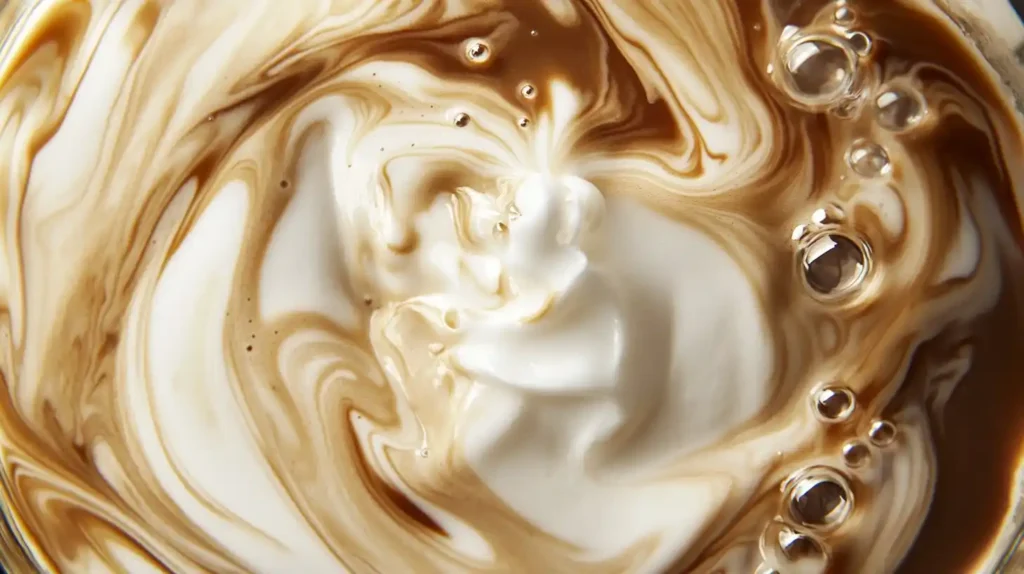Cold foam has revolutionized the way coffee enthusiasts enjoy their favorite beverages, transforming ordinary iced drinks into luxurious café-quality experiences.
This silky, cloud-like topping, when crafted properly, creates a perfect balance of texture and taste that slowly cascades through your drink. While many coffee shops charge a premium for this indulgent addition, mastering the technique at home is both straightforward and cost-effective.
Let me explain the key elements of temperature, equipment, and ingredients to you so you can create professional-grade cold foam that rivals leading coffee establishments.
Quick Summary
- Use cold 2% or whole milk, blend with vanilla syrup and a pinch of salt for 20-30 seconds until thick and creamy.
- Chill your equipment beforehand and ensure milk is very cold for optimal foam texture and stability.
- Avoid overwhipping the milk, as this will create whipped cream instead of light, airy cold foam.
- Pour the foam slowly along the side of the glass and let it settle for 30 seconds before serving.
- Add flavorings before frothing and start with half the recommended amount, adjusting to taste as needed.

What Is Cold Foam
Cold foam is a creamy, frothy topping made by blending cold milk or cream at high speeds until it develops a smooth, velvety texture with tiny, uniform bubbles.
Unlike traditional hot foam used in lattes, cold foam maintains its structure and doesn’t immediately dissolve when added to cold drinks. Certain materials, like those found in the Aeropress plunger gasket, can be affected by coffee oils, but the proteins in milk are not, allowing cold foam to maintain its structure.
Think of it as the cooler, more sophisticated cousin of whipped cream. But here’s the thing – it’s way less sweet and way more versatile.
The magic happens when proteins in the milk are whipped to create a stable, airy structure that sits prettily on top of your drink.
Key characteristics of cold foam:
- Light and fluffy texture
- Holds its shape for several minutes
- Perfect for iced beverages
- Can be flavored with syrups or spices
Let’s be real – cold foam has revolutionized the coffee game. It’s not just for fancy coffee shops anymore. Whether topping an iced americano or cold brew, this luxurious layer adds a creamy dimension that regular milk just can’t match.
And unlike hot foam? This stuff actually stays put. No immediate melting. No disappointing disappearing act.
Essential Ingredients
Creating the perfect cold foam starts with selecting the right ingredients. Truth is, you only need a few key items to make magic happen in your cup. Let’s get straight to what matters.
For those looking for a dairy-free alternative, oat milk can be a great substitute, as seen in iced oat milk lattes iced oat milk lattes. However, when it comes to cold foam, traditional milk is still the best option. Essential Components:
- Cold milk (2% or whole works best – none of that watery skim stuff)
- Vanilla syrup (optional, but recommended)
- A pinch of salt (trust me on this one)
Here’s the thing about milk – fat content matters. Nonfat milk? Save it for your cereal. The proteins and fats in 2% or whole milk create that luxurious, velvety texture we’re after. Period. Additionally, oat milk’s natural sweetness can be a great addition to cold brew coffee, but it’s not the best choice for cold foam.
For vanilla cold foam, quality vanilla syrup is non-negotiable. Skip the artificial garbage. Spring for pure vanilla syrup, or better yet, make your own with real vanilla beans. That tiny pinch of salt? It’s the secret weapon that enhances sweetness and brings out flavor notes you didn’t even know existed.
Temperature is vital. Your milk needs to be COLD. Like, straight-from-the-fridge cold. Room temperature milk? Don’t even think about it. You’ll end up with sad, deflated foam that nobody wants.
Tools You Need
For making perfect cold foam, the right tools are just as essential as quality ingredients. Let’s face it – you can’t whip up dreamy foam with just good intentions and a spoon. You need the proper equipment.
Consider investing in a high-quality frother, like the Aeroccino 3 or 4, which offers advanced features such as multiple frothing options.
With a powerful motor and quiet operation, these frothers can efficiently froth and heat milk to the desired temperature and texture.
Must-have tools for cold foam success:
- Electric milk frother (handheld or standalone)
- Tall container or frothing pitcher
- Measuring cups/spoons
- Metal mixing bowl (for chilling)
Here’s the truth: while some people swear by manual frothers or French presses, an electric frother is non-negotiable for that perfect microfoam texture.
Don’t cheap out on this one. Trust me.
For instance, the Aeroccino 4’s ceramic interior is easy to wipe clean and maintain, making it a great choice for those who value ease of use and cleaning.
The container matters too. You need something tall and narrow – wider containers just won’t cut it. The foam needs room to expand without making a mess all over your counter. Been there, done that.
Temperature is vital, so that metal mixing bowl? It’s your best friend for keeping everything properly chilled. Warm foam is just sad foam.
One last thing: measuring tools aren’t optional. “Eyeballing it” is for amateurs. Precise measurements = consistent results. Period.
Basic Cold Foam Recipe
Now that you have your tools ready, mastering the basic cold foam recipe will set the foundation for all your coffee creations. It’s surprisingly simple, yet people somehow manage to mess it up. Let’s fix that.
Here’s what you need:
- 1/2 cup cold 2% milk (whole milk works too, but skip the skim – seriously)
- 2 tablespoons vanilla syrup (optional, but recommended)
- Pinch of salt (trust me on this one)
The process is straightforward:
- Pour the cold milk into your milk frother
- Add vanilla syrup if using
- Drop in that tiny pinch of salt
- Froth for 20-30 seconds until thick and creamy
Don’t overthink it.
Your foam should be thick enough to float on top of your coffee but still pourable. If it’s runny, you didn’t froth long enough. If it’s too stiff, you went overboard. Finding that sweet spot takes practice.
The real magic happens when you nail the consistency. Perfect cold foam should hold its shape for at least 5 minutes on top of your drink. Anything less is just sad, cloudy milk.
Flavoring Your Cold Foam
Customizing cold foam with flavors opens up endless possibilities for crafting signature coffee drinks. The key is starting with quality ingredients and not overdoing it. Less is more, people!
Basic flavor additions that absolutely rock:
- Vanilla syrup or extract
- Caramel sauce
- Hazelnut syrup
- Pumpkin spice (basic? maybe. delicious? absolutely.)
- Cinnamon powder
- Cocoa powder
Want to get fancy? Try these killer combinations:
- Vanilla + lavender (sooo good!)
- Caramel + sea salt
- Mocha + mint
- Maple + cinnamon
- White chocolate + raspberry
Pro tips for flavoring success:
- Add flavoring before frothing
- Start with half the amount you think you need
- Taste test before adding more
- Remember cold drinks need stronger flavoring
Here’s the truth: some combos just don’t work.
Banana-flavored cold foam? Hard pass. Stick to complementary flavors that make sense with coffee.
And please, for the love of caffeine, don’t dump in three different syrups thinking more is better. It’s not.
The perfect cold foam is about balance. Nail that, and you’re golden.
Common Cold Foam Mistakes
Making perfect cold foam can be a delicate balancing act, and even experienced baristas occasionally stumble into common pitfalls that compromise the final product. Let’s plunge into the mistakes you need to avoid – trust me, I’ve seen them all.
First up: temperature matters. Using milk straight from the fridge? Big mistake. Room temperature milk foams better. Period. And don’t get me started on people who try to use whole milk – it’s just not going to work well, folks.
First up: temperature matters. Using milk straight from the fridge? Big mistake. Room temperature milk foams better. Period. And don’t get me started on people who try to use whole milk – it’s just not going to work well, folks.
Other classic blunders:
- Over-whipping until it’s basically whipped cream
- Using old or expired milk (gross!)
- Adding flavoring after foaming (rookie move)
- Not cleaning the frother properly between uses
- Choosing the wrong milk alternative (some just don’t foam well)
The biggest sin of all? Rushing the process. You can’t hurry perfection, and that perfectly-textured cold foam needs time. About 20-30 seconds, to be exact. Any less and you’ll end up with sad, lifeless foam that dissolves faster than your morning motivation.
Oh, and please stop trying to make cold foam in a blender. Just stop.
Storage and Make-Ahead Tips
While avoiding common mistakes helps create perfect cold foam, proper storage knowledge guarantees you can maintain its quality over time. Let’s get real about keeping that fluffy goodness fresh – because nobody wants sad, deflated foam.
Key storage tips that actually work:
- Never store pre-made cold foam for more than 2 hours
- Keep foam in a sealed container in the fridge if you must
- Use within 30 minutes for best results
- Don’t even think about freezing it – just don’t
Here’s the brutal truth about make-ahead prep:
- Pre-measure your ingredients and keep them ready
- Mix your flavoring syrups in advance
- Clean and chill equipment beforehand
- That’s it. Seriously.
Look, cold foam is like that high-maintenance friend – demanding but worth it. The moment you make it, it starts breaking down.
No amount of careful storage will give you that fresh-made magic after a few hours.
Sure, you can try storing it, but why settle for mediocre foam when fresh takes just two minutes to whip up? Your taste buds will thank you for the extra effort.
Best Milk Options
From creamy whole milk to plant-based alternatives, selecting the right milk for cold foam can make or break your beverage experience. Not all milks are created equal when it comes to creating that perfect, luxurious foam.
Best options for cold foam:
- Whole milk – The undisputed champion. Rich, creamy, and foams like a dream
- 2% milk – A solid runner-up, still creates decent foam
- Oat milk – The best non-dairy option, hands down
- Nonfat milk – Creates stiff foam but lacks richness (boring!)
Avoid these at all costs:
- Almond milk – Too watery, separates quickly
- Coconut milk – Too heavy, weird texture
- Rice milk – Just… no
Temperature matters! Always use cold milk straight from the fridge. Room temperature milk is a rookie mistake that’ll ruin your foam game. And please, for the love of coffee, skip those weird “barista blend” alternatives that cost twice as much. Regular whole milk works perfectly fine.
Remember: the higher the fat content, the silkier the foam. Simple as that.
Topping Your Drinks
Successfully topping drinks with cold foam requires precision and technique to achieve that perfect layered effect. The key is to pour slowly and steadily – rush it and you’ll end up with a mess. Your foam should gently cascade over the drink, creating distinct layers that look Instagram-worthy.
Here’s what you need to know about proper topping technique:
- Pour along the side of the glass, not directly in the center
- Use a spoon to guide the foam if needed
- Keep a steady hand – shaking means sloppy results
- Let the foam settle for 30 seconds before serving
The most common mistakes? Pouring too quickly or from too high up. Both will destroy that beautiful separation you’re trying to achieve.
Want to get fancy? Try these pro moves:
- Create patterns with drizzles on top
- Dust with cocoa powder
- Add colorful sprinkles
- Use stencils for designs
Remember: Presentation matters. Your drink should look as good as it tastes.
Creative Recipe Variations
Countless creative variations exist for cold foam recipes, each offering unique flavor profiles and textures. Let’s plunge into some game-changing combinations that’ll make your basic cold foam look absolutely boring.
Try these amazing variations:
- Vanilla-lavender: A dash of culinary lavender and pure vanilla extract. Fancy? Yes. Worth it? Absolutely.
- Salted caramel: Mix in caramel sauce and a pinch of sea salt. Simple but mindblowing.
- Pumpkin spice: Because obviously. Add real pumpkin puree and spices – none of that artificial stuff.
- Mocha: Cocoa powder and a splash of espresso. Chocolate lovers, you’re welcome.
Want to get wild? Here are some unexpected twists:
- Matcha mint: Green tea powder with a hint of peppermint
- Brown sugar cinnamon: Like a cinnamon roll in foam form
- Cookie butter: Yes, you can foam-ify your favorite spread
- Maple bourbon: A splash of bourbon extract with real maple syrup
Remember: quality ingredients matter. Don’t cheap out on the basics. And please, for everyone’s sake, skip the artificial sweeteners – they mess with the foam’s texture.
Nobody wants sad, deflated foam.
Alex is a self confessed coffee addict – but he takes his love of caffeine seriously in a completely responsible way. He loves trying new coffees and testing the latest machines and is not usually fan of one button pod machines. Alex is happiest when he is tinkering with settings and milk temperatures to create the perfect cup. When not obsessing over coffee, Alex is a keen musician and plays weddings and other social events (usually fuelled by… yes, you guessed it… coffee).


